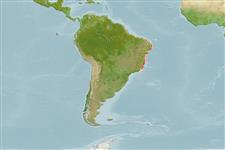分類 / Names
共通名の | 類義語 | Catalog of Fishes(部類, 種) | ITIS | CoL | WoRMS | Cloffa
>
Gobiiformes (Gobies) >
Gobiidae (Gobies) > Gobiinae
Etymology: Gobiosoma: Latin, gobius = gudgeon + Greek,soma = body (Ref. 45335); alfiei: Named for Alfredo Carvalho-Filho or Alfie, as he calls himself..
Environment: milieu / climate zone / depth range / distribution range
生態学
海; 深さの範囲 0 - 1 m (Ref. 104557). Tropical
Southwest Atlantic: Brazil.
サイズ / 重さ / 年齢
Maturity: Lm ? range ? - ? cm
Max length : 2.8 cm SL オス/雌雄の選別がない; (Ref. 104557)
簡単な記述
形態学 | 形態計測学
背面の脊椎 (合計): 7 - 8; 背鰭 (合計): 8-11; 肛門の骨 1; 臀鰭: 8 - 9. This species is distinguished from its congeners by the following set of characters: scaled body from caudal peduncle to base of pectoral fin, scales in a wedge shape to under posterior of
first dorsal-fin base, continuing anteriorly in a row of 3-4 scales, row slightly tapering anteriorly; naked area extending from mid-pectoral-fin base to 4th-11th ray of second dorsal fin (rarely extending further) and from the mid-pectoral-fin base to 3rd-9th anal-fin ray (rarely extending further); upper jaw 21.5% in head length; lateral scales modally 29; individuals 15 mm SL or larger have 24+ scales; pectoral fin 18 (17-20) (Ref. 104557).
Occurs in shallow tidepools which are generally, depressions in the calcareous material with a sand and gravel substrate; tidepool edges covered by algal turf, soft macro-algae, coralline algae and a few soft and hard corals; reef surface generally flat and pools frequently interconnect with each other through both overflows and an extensive system of dissolution holes and channels. The same pools are shared, but not necessarily the same microhabitat, by sympatric gobies which include Bathygobius geminatus Tornabene, Baldwin & Pezold 2010 (most abundant), Bathygobius soporator (Valenciennes 1837), Barbulifer enigmaticus (Joyeux, Van Tassell & Macieira 2009), Coryphopterus glaucofraenum Gill 1863 and Ctenogobius saepepallens (Gilbert & Randall 1968) (least abundant). This species is not limited to the intertidal zone for underwater observations in the state of Alagoas (northeastern Brazil) at about three meters depth (low tide) showed several living on (and in) a rock outcrop located under a reef ledge (the outcrop was composed of encrusting coralline algae, interspersed with filamentous and turf-like algae). Usually, isolated (single) individuals were observed perched at the entrance of a small hole in the calcareous rock, occasionally biting at the substrate, and darting into the hole at the slightest disturbance. An individual was observed, in one occasion, chasing another, both finally entering the same hole and not reappearing during the observation period. In NE Brazil, the state of Paraíba, the species was observed in subtidal areas (about three meters depth) under a small, flat, rounded stone lying on top of a flat clay substrate and upon lifting the stone, the fish disappeared into a small round hole in the substrate. In the state of Espírito Santo, in a 15 cm deep tidepool, this species was observed entering and exiting one of the numerous holes in the clay along the side of the pool. Swimming for this species was limited to close contact with the bottom, in small (1-10 cm) darts, starting and ending in protected areas (i.e., under stones, near holes, into cavities). Also, breeding males were observed perched near holes for extended periods, moving up to 30 cm away, before entering/exiting the hole (Ref. 104557).
Life cycle and mating behavior
成熟 | 繁殖 | 放精 | 卵 | 生産力 | 幼生
Van Tassell, J.L., J.-C. Joyeux, R.M. Macieira and L. Tornabene, 2015. Status of Gobiosoma (Teleostei: Gobiidae) from Brazil: description of a new species, redescription of G. hemigymnum, molecular phylogeny of the genus, and key to Atlantic species. Zootaxa 4007(4):451-480. (Ref. 104557)
Human uses
より多くの情報
共通名の類義語代謝捕食動物生態毒性繁殖成熟放精卵の集合体生産力卵卵の開発
Age/Size成長体長-重さLength-length体長組成形態計測学形態学幼生幼生の動力補充豊度BRUVS
参考文献水産養殖水産養殖の紹介緊張遺伝子のElectrophoreses遺伝病気行列NutrientsMass conversion
協力者画像Stamps, Coins Misc.音シガテラ(食中毒の名前)速度泳ぐ 型式カマOtoliths脳視覚
用具
特記事項
XMLをダウンロードして下さい
インターネットの情報源
Estimates based on models
Phylogenetic diversity index (Ref.
82804): PD
50 = 0.5000 [Uniqueness, from 0.5 = low to 2.0 = high].
Bayesian length-weight: a=0.00708 (0.00333 - 0.01504), b=3.09 (2.92 - 3.26), in cm total length, based on LWR estimates for this (Sub)family-body shape (Ref.
93245).
栄養段階 (Ref.
69278): 3.1 ±0.3 se; based on size and trophs of closest relatives
回復力 (Ref.
120179): 高い, 15か月以下の倍増期間の最小個体群 (Preliminary K or Fecundity.).
Fishing Vulnerability (Ref.
59153): Low vulnerability (10 of 100).
